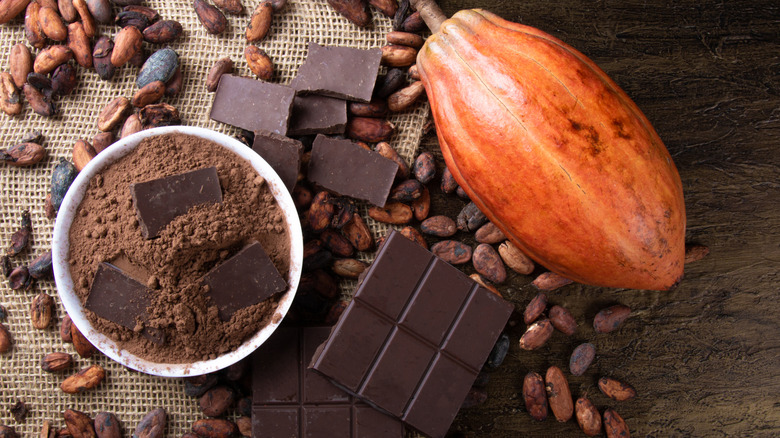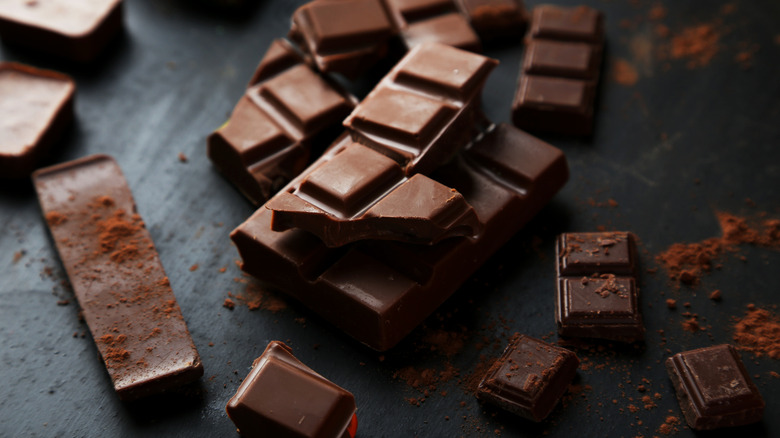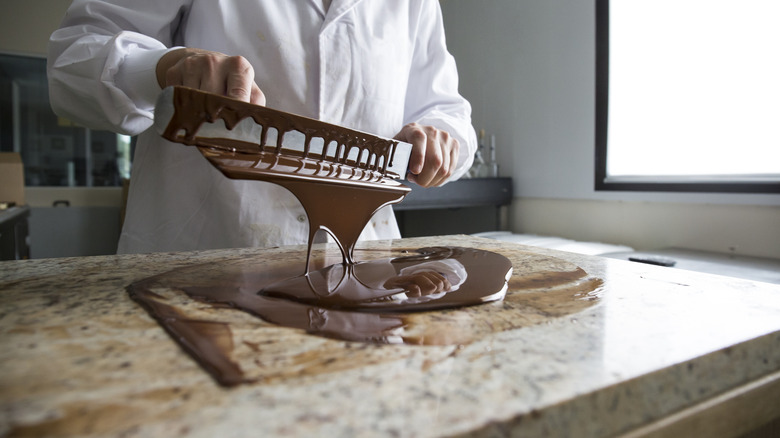What Is A Bean-To-Bar Chocolate-Maker, And How Does It Differ From Other Chocolate Producers?
Simply having a preference for cocoa percentage in chocolate isn't enough to narrow down your choices to the perfect bar. Our favorite chocolate confections can now also come with labels such as "craft" or "artisanal." While sometimes it's simply a tactic brands use to differentiate their products, some descriptors can tell you a lot about the chocolate and its origin. One in particular, bean-to-bar, has grown increasingly popular, and the phrase has come to encompass many of the qualities that would appeal to someone looking for a high-quality chocolate bar.
At its simplest, bean-to-bar chocolate conveys the idea that the chocolate maker manages the entire process, starting from the cocoa bean to when it is a ready-to-eat chocolate bar. The reason behind it is to increase transparency and ensure sustainable and ethical sourcing and processing methods are followed in the making of the chocolate. Conversely, large-scale chocolate producers use vast quantities of cocoa that they often source it from intermediate suppliers, and are therefore not in direct contact with cocoa growers. Chocolatiers usually procure chocolate in an even later stage of production and use it to make confectionery.
Large-scale production of cocoa to meet global demand, and the fact that most of it is grown in economically developing countries, means that the cocoa industry is fraught with unsustainable agricultural processes and questionable labor practices. In addition to knowing where your bean-to-bar chocolate is sourced from, you can also expect a more distinct flavor profile since the cocoa beans are more carefully selected and processed. Of course, the smaller-scale production of bean-to-bar chocolates also makes them more expensive.
Bean-to-bar chocolate makers vs. big chocolate companies
The journey from cocoa bean to a chocolate bar is a complicated one. It starts with harvesting, fermenting, drying, and roasting the beans before they're ground, tempered, and finally molded into chocolate bars. A bean-to-bar manufacturer tries to encompass the majority of these steps, or at the very least monitor them carefully. On the other hand, big chocolate companies that manufacture the most widely consumed chocolates, such as Nestlé, Hershey, and Mars, outsource many of the steps that go into processing cocoa, including sourcing cocoa that has already undergone the initial stages of processing. While a bean-to-bar chocolate maker likely specifies where its cocoa originates, large chocolate companies use certifications from organisations such as Rainforest Alliance and Fairtrade International to signal that their cocoa is ethically sourced.
The massive quantities of chocolate produced by these companies allow for economies of scale, which keep their product prices low. Bean-to-bar chocolate makers churn out much lower quantities, which makes their products more expensive. However, they also tend to use higher-quality ingredients, resulting in a bar that has deeper, more complex flavors. In fact, the award-winning chocolate considered to be the best in the world has only two ingredients: Cocoa grown on a specific Peruvian farm and sugar. Conversely, the bulk cocoa sourced by large manufacturers tends to have a more subdued and bitter flavor profile, so they end up using more artificial flavoring in their chocolate bars.
Bean-to-bar chocolate makers vs. chocolatiers
Chocolatiers usually get their cacao even further down the production chain because they are more focused on working with chocolate to create confections rather than simply making bars of chocolate. As opposed to manufacturing it, a chocolatier elevates regular chocolate by sculpting and flavoring it in novel, sometimes artistic ways. They also focus on the chocolate's texture, and tempering chocolate is often an important aspect of a chocolatier's work.
Chocolatiers can get their chocolate from any type of chocolate manufacturer, so their cocoa sources tend to be the most opaque. More often than not, chocolatiers source from large chocolate-producing companies because of the lower costs. However, since they are often associated with high-end or specialty confections, chocolatiers use higher-quality chocolate than what you'd find in a regular chocolate bar. Couverture chocolate, for example, is the raw ingredient of choice for many chocolatiers because it contains a higher proportion of cocoa butter, giving it a richer texture and a glossy appearance. Interestingly, while chocolatiers are known for making high-end confections, To'ak — the world's most expensive chocolate — was inspired by bean-to-bar chocolates and takes things a step further by harvesting cacao from a rare cacao tree variety.


